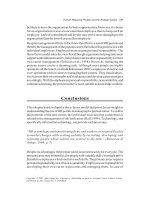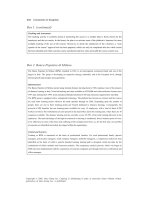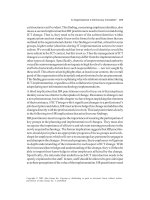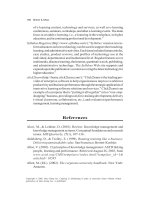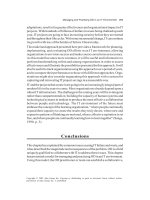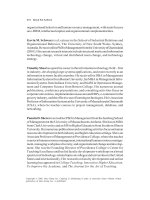Competency-Based Human Resource Management
Bạn đang xem bản rút gọn của tài liệu. Xem và tải ngay bản đầy đủ của tài liệu tại đây (2.9 MB, 308 trang )
Competency-Based
Human Resource
MANAGEMENT
Competency-Based
Human Resource
MANAGEMENT
D A V I D D. D U B O I S
W I L L I A M J. R O T H W E L L
With
DEBORAH JO KING STERN
LINDA K. KEMP
Davies-Black Publishing
Mountain View, California
Published by Davies-Black Publishing, a division of CPP, Inc., 1055 Joaquin Road,
2nd Floor, Mountain View, CA 94043; 800-624-1765.
Special discounts on bulk quantities of Davies-Black books are available to corporations, professional associations, and other organizations. For details, contact the
Director of Marketing and Sales at Davies-Black Publishing; 650-691-9123;
fax 650-623-9271.
Copyright 2004 by Davies-Black Publishing, a division of CPP, Inc. All rights
reserved. No part of this book may be reproduced, stored in a retrieval system, or
transmitted in any form or by any means, electronic, mechanical, photocopying,
recording, or otherwise, without written permission of the publisher, except in the
case of brief quotations embodied in critical articles or reviews.
Myers-Briggs Type Indicator is a trademark or registered trademark of the MyersBriggs Type Indicator Trust in the United States and other countries. Sixteen Personality Factor is a trademark and 16PF is a registered trademark of NCS Pearson, Inc.
Strong Interest Inventory, Davies-Black, and its colophon are registered trademarks
and California Psychological Inventory and CPI are trademarks of CPP, Inc.
Visit the Davies-Black Publishing Web site at www.daviesblack.com.
Printed in the United States of America.
12 11 10 09 08 10 9 8 7 6 5 4
Library of Congress Cataloging-in-Publication Data
Competency-based human resource management / David D. Dubois . . . [et al.].
— 1st ed.
p. cm.
Includes index.
ISBN 978-0-89106-174-8
1. Personnel management. I. Dubois, David D.
HF5549.C7115 2004
658.3—dc22
2003023886
FIRST EDITION
First printing 2004
To the life and memory of my late mother, Edith M. Dubois, who inspired me to persevere
in the face of seemingly impossible obstacles, to love when it was difficult to do so, to care
when others did not, and to have the courage to stand alone when it was correct to do so.
—David D. Dubois
To my wife, Marcelina Rothwell, and daughter, Candice Rothwell.
Without them, my life would not have the same meaning.
—William J. Rothwell
To my mother and father, Verna and Floyd D. King.
—Deborah Jo King Stern
To my teachers and friends, Dr. Lee J. Richmond, professor at
Loyola College, Maryland, and Richard W. Bolles, author of
What Color Is Your Parachute?
—Linda K. Kemp
Contents
Figures and Forms ix
Preface xi
Acknowledgments xv
Part One: Finding a New Focus
Chapter 1
Why a Focus on Jobs Is Not Enough 3
Chapter 2
An Overview of Competency-Based HR Management
Practices 15
Part Two: Understanding Competency-Based
HR Management
Chapter 3
A Need for Implementing Competency-Based
HR Management 43
Chapter 4
Competency-Based HR Planning 61
vii
viii
Competency-Based Human Resource Management
Chapter 5
Competency-Based Employee Recruitment and
Selection 95
Chapter 6
Competency-Based Employee Training 125
Chapter 7
Competency-Based Performance Management 141
Chapter 8
Competency-Based Employee Rewards 163
Chapter 9
Competency-Based Employee Development 183
Part Three: Transitioning to Competency-Based
HR Management
Chapter 10
The Transformation to Competency-Based
HR Management 219
Chapter 11
Competency-Based HR Management: The Next Steps 233
Appendixes
A: Frequently Asked Questions About CompetencyBased HR Management 241
B: Further Suggestions on Employee Development 247
C: Examples of Life-Career Assessment Exercises 251
D: Employee Development and Succession Management
255
Notes 257
References 263
Index 281
Figures and Forms
Figures
1
Comparison of Traditional and Competency-Based HR
Management 11
2
A Model to Guide the Implementation of Strategic HR
Management 54
3
Implementing Competency-Based HR Planning 76
4
Dynamic Relationships 85
5
Summary of Competency Inventory Data Useful for
HR Planning 93
6
Traditional Recruitment Process 97
7
Traditional Selection Process 100
8
Competency-Based Employee Recruitment and Selection 113
9
Competency-Based Performance Management 147
ix
x
Competency-Based Human Resource Management
10
Implementing Competency-Based Performance Management 156
11
Competency-Based Employee Reward Process 175
12
The Three-Step Process for Choosing the Correct Work 190
13
Implementing Competency-Based Employee Development 200
14
A Model for Transforming the HR Function 222
15
An Example of the Use of Kemp’s Life-Career World Wheel 252
Forms
1
Job Description and Job Specification (Sample) 7
2
Traditional Worker Skills Inventory Questionnaire 68
3
Worker Competency Inventory Questionnaire 70
4
Assessing the HR Function 223
5
Selecting Which HR Functions Should Become
Competency Based 224
6
Expected Roles, Competencies, and Outputs 226
7
Educating Key Stakeholder Groups on Competency-Based HR
Management 227
8
Important HR Practitioner Competencies and Associated
Behaviors 229
9
Assessing the Competency-Based HR Practitioner 230
Preface
Human resource (HR) management is undergoing a major transformation in today’s organizations. Once upon a time—and not all that long
ago—HR management practitioners were expected to be the traffic cops
of their organizations. It was their responsibility to note legal noncompliance or departures from organizational policies and then punish
transgressors, just as traffic cops watch for and issue tickets to drivers
who exceed speed limits. As a direct consequence of this compliance orientation, some HR management practitioners became risk averse—and
some remain so to this day. They oppose innovative actions taken to
leverage the talents of organizational members for the simple reason
that treading on new ground means taking new risks, which could possibly cause deviations from external legal requirements or internal policy standards.
The new role of HR management demands an outlook that differs
considerably from the compliance mind-set. HR management practitioners are expected to be experts on leveraging human talent within
their organizations for the purpose of achieving competitive advantage.
They must demonstrate new sensitivity to the full range of human capaxi
xii
Competency-Based Human Resource Management
bilities (including emotional intelligence), align HR efforts with strategic objectives, and integrate various HR activities so that people are consistently encouraged to achieve desired results.
For many practitioners, traditional writings on HR management do
more to stand in the way of progress than to facilitate it. One reason is
that traditional college textbooks on the field continue to define “jobs,”
“job descriptions,” and “work analysis” as making up the foundation for
most HR efforts. That view persists even as the work of Bill Bridges and
others who have noted that “jobs are dead” is described in the same
books. Traditional textbooks on HR management, although important
because they build expectations among HR professionals about the
nature of their role, do not address the critical importance of individual
differences, which create exemplary performers, who may be many times
more productive than others with the same job titles, education, and
experience. And yet the importance of individual characteristics, or
competencies, is well known to CEOs, operating managers, and others.
Recognizing critical differences in individual productivity implies that
more work might be done by fewer people, or that better work might be
done by the same number of people. Of course, that can only happen if
HR practitioners become more savvy about finding the best-in-class
performers, discover what makes them different from their fully successful counterparts, and reorient HR toward recruiting, selecting, training, developing, rewarding, appraising, and otherwise managing these
exceptional people.
This book offers a guide to the process of reinventing HR so that it
focuses on identifying those stellar individual characteristics and then
aligns all HR activities around them. The purpose of HR management is
thus not to describe “jobs” and find people to fit into boxes on organizational charts. Instead, its goal is to achieve quantum leaps in productivity and in competitive advantage by unleashing the power of exemplary performers, discovering their characteristics, and building those
characteristics into all aspects of HR.
Any person with an interest in effectively managing human
resources through a competency-based system is part of the audience for
this book. Such individuals might include HR leaders and practitioners,
organizational effectiveness and development managers, trainers,
employee or career development practitioners and facilitators, opera-
Preface
xiii
tions managers of all types, executive officers and their staffs, college or
university professors in fields related to human resources and executive
education, college or university administrators committed to improving
the use of human talent in their institutions, and others who are interested in utilizing human talent for maximum benefit.
Contents of This Book
Over the years, early thinkers and writers such as David McClelland and
Richard Boyatzis and others including Daniel Goleman, Patricia
McLagan, and Lyle and Signe Spencer have contributed to the field’s
wide knowledge base. Further, the models for adopting individual competency-based HR management functions are supported, at least in part,
by recently published case reports that attest to the validity of the approaches in specific settings. As others try out the (sometimes untested)
suggestions in this book, they will discover the best methods for implementing competency-based HR management. We hope this new knowledge, shared with others, will be used to raise the state of the art and of
the practice.
Part 1, which comprises the first two chapters, explains the background and presents a rationale for reinventing HR management with a
competencies rather than a jobs foundation. In this sense, the book is
revolutionary in its approach to HR management.
Chapter 1 presents and analyzes several vignettes that illustrate the
necessity of shifting HR management to a competency foundation in
most organizations. Chapter 2 contains an overview of competencybased HR management practices. Key terms are defined in the context of
their use in later chapters. This chapter also explains the business needs
that are met through competency-based HR management and the ways
in which the use of competencies can be aligned with business plans,
objectives, and needs.
Part 2 is composed of seven chapters and will help the reader to
understand the details of competency-based HR management on a
function-by-function basis.
Chapter 3 presents a model for the establishment of a competencybased HR management function. The model is positioned as a response
to conclusions drawn from a vignette and the discussion of six trends
xiv
Competency-Based Human Resource Management
affecting businesses and organizations. Chapters 4 through 9 offer models—presented in a step-by-step format—for developing competencybased HR planning, employee recruitment and selection, employee
training, performance management, employee reward processes, and
employee development. The chapters offer suggestions for implementing each model. In addition, we take a frank look at the advantages and
challenges of using a competency-based approach for each HR management function and provide criteria by which to determine whether the
area should become competency based or be managed traditionally.
Part 3, which consists of chapters 10 and 11, is devoted to helping
readers understand how to handle the transition from a jobs-based to a
competency-based HR management system.
Chapter 10 presents a model for transforming HR into a competency-based department and explains the process of applying that
model. The chapter concludes by addressing a critical question, namely,
“How can HR practitioners become competent in the new approach?”
The answers are essential to a successful transition to competency-based
HR management.
Chapter 11, the final chapter, examines the next steps for competency-based HR management by discussing its future direction and
anticipated innovations. The chapter concludes by reviewing methods
of adoption and use as well as some of the challenges involved in applying competency-based practices to traditional jobs-based organizations.
Acknowledgments
With each new book project, we are reminded over and over that the
support of others is essential to achieving a successful result. This project is no exception.
David Dubois acknowledges those colleagues and clients—far too
many to thank individually here (but they know who they are)—who
encouraged him to write this book. Remembering their words helped
him to tackle this work and to urge the other authors to make this book
a reality despite the obstacles they all faced. He acknowledges the monumental efforts of Connie Kallback, developmental editor, and the
numerous contributions and encouragement she offered along the way.
Linda Kemp and David Dubois acknowledge the influence of Drs.
Anna Miller-Tiedeman and David Tiedeman on the development of the
“life-career” concept, which affected the thinking behind the employee
development practices in this book. They also thank Dr. Lee J.
Richmond for her unselfish efforts—over many years—to bring us (and
others) together in forums that enabled us to gain a deeper understanding of the “life-career” paradigm and its significance for employee development. Thanks to all!
xv
xvi
Competency-Based Human Resource Management
Deborah Jo King Stern extends a most sincere “thank you” to family,
friends, and colleagues for their support. She especially wishes to thank
the co-authors for their many contributions and for leading this project
to fruition. She also expresses her gratitude to her husband and children
for their understanding, to her mother for the constant words of
encouragement and never-ending faith, and to her father for his belief in
her. She thanks her sister for always being there. A warm thank-you, too,
goes to those she has met along the way and who have offered much
inspiration.
Finally, the authors wish to thank those individuals at Davies-Black
Publishing who contributed their time and talents to this project.
Part One
FINDING A
New Focus
C H A P T E R
1
Why a Focus on Jobs
Is Not Enough
This chapter describes the challenges facing today’s human resource
(HR) practitioners and offers justification for a new way of thinking
about human resource management. The following five vignettes portray HR situations in fictitious organizations. Readers are prompted to
write down a solution to the problem presented in each vignette; then
the vignettes are analyzed. Next, we discuss the problems that result
when organizations focus on jobs as the criterion for matching employees with the work that is essential to organizational success. The chapter
closes with an answer to the question, What are the major HR management subsystems in organizations today?
Five Vignettes
First, take out a sheet of paper. Next, read over each of the following
vignettes. As you read each vignette, record what you believe should be
done to solve the problem described.
3
4 Competency-Based Human Resource Management
Vignette 1
John Parks, director of HR for Acme Corporation, is upset. He remarks
to his secretary, “It seems like the only thing we do in this department is
look for people to hire. We’re always churning people. We don’t have
time to stem the turnover by taking a proactive approach to human
resources. Instead, we are always looking for warm bodies to fill the latest vacancies.”
Vignette 2
The senior vice president of operations has just been informed by the
CEO that he must let go of 20% of his staff within 30 days in order to
cut costs. He sends a memo to his direct reports, instructing them to
reduce their work units by 20% of the committed working hours. He
then leaves for a 3-week vacation. His direct reports are left guessing as
to how to implement the order and how to handle the consequent fallout. The senior vice president is not available to consult for advice.
Vignette 3
The CEO and the director of marketing approach an international
organization with a proposal to provide services in an area outside the
company’s core business. They do not expect to win the business, but
much to their surprise, they are awarded the contract. At this point, they
begin to wonder how they will staff for the work. The first person they
call is the director of HR; she is told to recruit five different specialists
who must report within 6 weeks. The director of HR is given little information to guide the search.
Vignette 4
The director of HR in a large organization of more than 20,000 employees examines the projected retirement dates of the senior executive
group. To their chagrin, the executives learn that 80% of their key group
is eligible for retirement within 2 years. The CEO assigns the vice
president of HR the task of preparing a succession plan for building an
internal talent pool sufficient to meet the expected shortfall of executive
talent.
Why a Focus on Jobs Is Not Enough 5
Vignette 5
The Axeljocanda Corporation has a long history of preparing and
using high-quality strategic business plans. In this organization, the
HR department operates as an administrative, paper-pushing work
unit. The department has performed job analysis and job performance
assessment on only a few key jobs in the organization, leaving the rest
unexamined.
In Axeljocanda’s corporate culture, department managers commonly do not compare notes with their peers about initiatives in their
departments. As a direct consequence, the compensation manager has
never met with the training director or with the director of employee
relations. Furthermore, the vice president of HR has never been invited
to participate in strategic business planning retreats with the other senior executives.
Analysis of the Vignettes
Think for a moment about what happened in these vignettes. In
Vignette 1, the HR department is too busy churning people to focus on
results and determine how best to achieve them. In Vignette 2, middle
managers find themselves facing the difficult task of reallocating work
responsibilities simply to achieve short-term cost savings. In Vignette 3,
the organization is experiencing a need for talent and does not know
how to get it. In Vignette 4, a highly competent vice president of HR
faces the challenges of developing, in the short term, a plan to meet
long-term requirements. In Vignette 5, the HR department is neither
vertically aligned with organizational strategy nor horizontally aligned
among its own functions.
The Problem With Focusing on Jobs Alone
The vignettes described in the previous section dramatically underscore
some of the problems facing HR professionals and their organizations
today.
Traditionally, job analysis—the process of identifying the work that
people do—has been the foundation of HR department activities.
According to a classic treatment by Walker (1980), a job analysis has four
6 Competency-Based Human Resource Management
possible purposes. Each purpose provides a view of the job from a different angle; therefore, each is identified by a slightly different approach.
One purpose is to discover what people do in their jobs. This approach
takes a close look at the reality of the jobs. A second purpose is to find
out what people think job incumbents do in their jobs. This approach
seeks to gather perceptions about the jobs. A third purpose is to ascertain what people or their immediate supervisors believe job incumbents
should be doing at their jobs. This approach determines the job norms.
A fourth purpose is to determine what people or their supervisors
believe job incumbents are doing or should be preparing to do in their
jobs in the future should changes occur in their workplace. This
approach to job analysis emphasizes planning for changes (Rothwell &
Kazanas, 1994, 1998).1
A job description, which tells what the incumbent does, and a job
specification, which clarifies the minimum requirements necessary to
qualify for a job, are major outputs of job analysis. Job descriptions and
job specifications, in turn, are key to such HR functions as employee
recruitment, selection, training, and performance management.
One problem with traditional job descriptions is that they are written only to clarify those activities job incumbents are supposed to perform and may not clearly describe measurable worker outputs or results
that meet the requirements for organizational success. If you doubt that,
examine Form 1, Job Description and Job Specification (Sample), which
contains a typical job description from an organization. Note that the
example does not list the desired outputs or results under the description of responsibilities.
Outputs or results are the products or services that workers produce
and deliver to others; recipients might include coworkers, constituents,
customers, or persons or organizations external to the workers’ organizations. Outputs or results should be produced to a level of quality that
meets or exceeds the receiver’s expectations.
Another problem with traditional job descriptions is that they
quickly become outdated. In today’s dynamic organizations, work activities do not remain the same for long. Job descriptions, however, rarely
keep pace with changes in work requirements. That leads to much confusion as people try to figure out whether a job description is current or
outdated.
Why a Focus on Jobs Is Not Enough 7
Form 1: Job Description and Job Specification (Sample)
PART I: JOB DESCRIPTION
Job title
Job analyst
Purpose of job
Conducts studies of work performed. Prepares job
descriptions and other information requested by
managers and HR practitioners.
Number of people supervised
None
Responsibilities
• Collects, analyzes, and prepares work information
for personnel, administrative, and management
functions.
• Consults with management to determine the purpose, range, and type of prospective studies.
• Studies the organization’s current work data and
compiles the necessary background information.
• Observes work processes and interviews workers
and supervisors to determine job and worker
requirements.
• Analyzes work data and develops written
summaries. Uses developed data to evaluate
methods and techniques for worker-related
programs; improves them if necessary. May
specialize in classifying positions to meet civil
service requirements.
• Performs other assigned duties.
PART II: JOB SPECIFICATION
Minimum education required
Bachelor’s degree with a specialty in HR management, general management, or a related field
Minimum experience required
None
Other essential qualifications
Patience, perseverance
8 Competency-Based Human Resource Management
Cornell University professors Patrick Wright and Lee Dyer conducted a study on how the HR profession will change because of technology. According to their preliminary findings, there is a possibility that
the job description will be “one of the first institutional fixtures of the
profession” to become obsolete (Leonard, 2000). Job descriptions will not
only be out-of-date before they are even written due to rapid change, but
may become obstacles for HR professionals who are trying to effect organizational change. Leonard further noted that job descriptions are carefully written to meet legal requirements and to list the organization’s
expectations for an employee but lack the flexibility needed today.
Again, examine the job description shown in Form 1. Assume you
are the supervisor of the person in the described position and ask yourself the following questions:
• How will I know if this worker demonstrates successful performance?
• How do I know that the job description is current?
Unfortunately, workers often have the same questions. They are left to
guess about the measurable outputs or results they are expected to produce, in what form, at what level of quality, and on what schedule.
Sometimes workers are not alone in playing this guessing game.
When they put those questions to a supervisor they might be greeted
with a blank stare or given answers too vague to make sense. Frustrated,
workers continue doing what they have always done—or what they have
seen others do—without knowing for certain whether they are achieving desired outputs. But when customers, supervisors, or managers do
not receive the products or services they expected on time or of sufficient quality, they blame the worker. This raises yet another question:
What is the supervisor’s responsibility for this dilemma?
This scenario illustrates a possibly three-fold problem. First, there
might be a mismatch between workers’ capabilities and the outputs or
results they are required to produce. Second, the information provided
could be inaccurate or incomplete. Third and finally, the expected outputs might not conform to traditionally defined jobs that are rigid, compact, and inflexible.
The point is that job descriptions are not enough. Yet the findings of
one survey, sponsored by the American Compensation Association and
conducted with a sample of 1,000 members and 219 respondents, seem to


